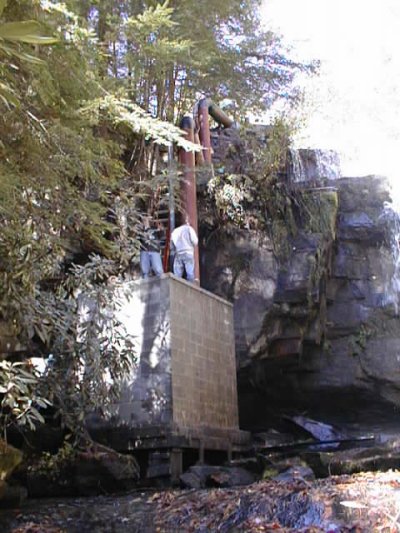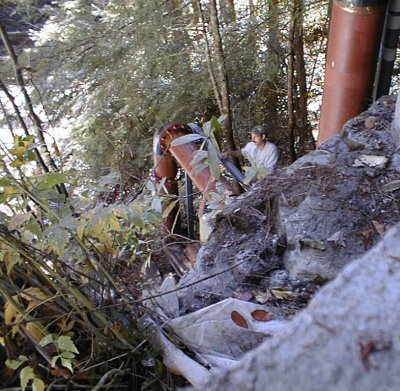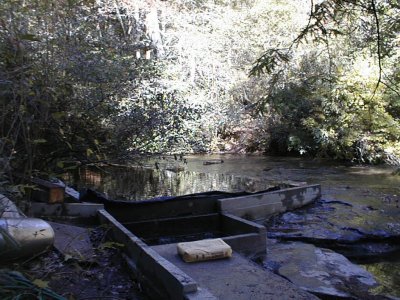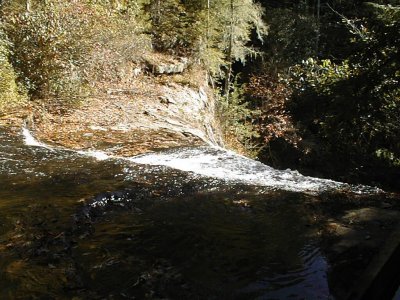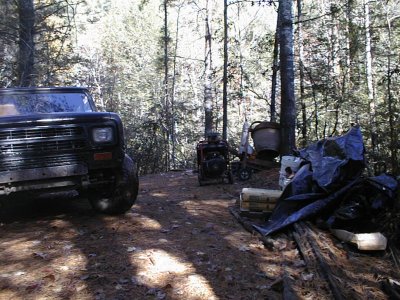Shoal Creek Power & Light
Lighting One House and a Few Smaller Buildings, Nationwide
This section is from my old place at Shoal Creek Falls. As the Realtors closed in around me, I felt a lot like the guy in Dire Strait's Telegraph Road. Check out my Blog entry called Leaving Walden for all the details. This section is popular enough that I've left it up so you can do it too if you want, and so people who want to try will know that, yes, it can be done. Most of this happened 1994-2005.
Check me out with long hair! Sixty-five cent Diesel fuel! Ah, back in the day ...

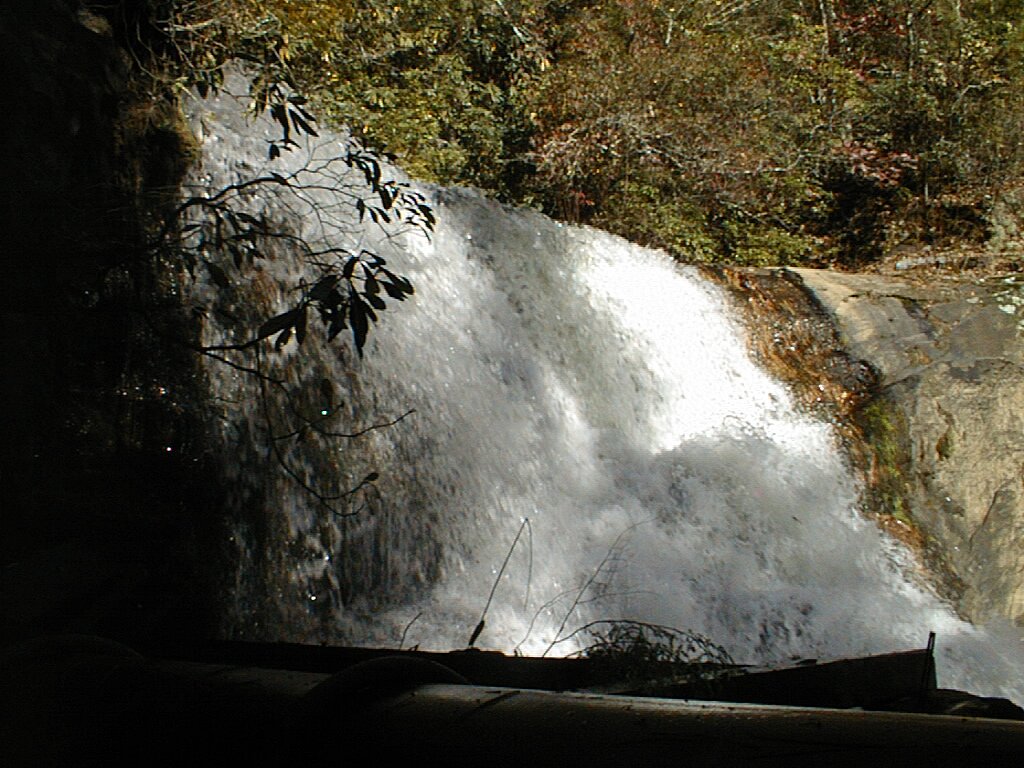
Anybody can call the power company and just hook up, right? Well, no way I could take the easy way out with a 60 foot waterfall at the edge of the property ...
Efficiency Counts
Really impressive acts of cultural silliness are to me what I guess football is to some people. The stats are out there for anyone to see, but they still blow me away. The US generates and uses most of the world's electricity. What are we doing wrong?It's been said that Lucas refrigerators started the tradition of warm English beer, but it's undeniably true that Europeans use phenomenally less power than we do. Ever see a European refrigerator or washer? Very small, efficient machines. Given that the efficiency of a small hydro plant is likely to be less than 50% and battery efficiency is maybe 70% on a warm sunny day with snacks and lemonade, you get to Richter's Rule of Power Management:
Every Watt you don't use is three (3) you don't have to generate.
Which is a pretty big deal. Efficient lights are cute, but the refrigerator alone sucks up about 15% of a typical home's energy budget according to the US Department of Energy. Sounds simple, but there it is.
SCP&L Unit #2 - Hydroelectric
Seems that I never get around to taking pictures of the stuff I build. I just hook 'em up and go on to the next gig. The photos on this page were all taken by Steve Scherb. Thanks man!
The pics above pretty much tell the tale, from intake to tailwater. You'll note that there is no machinery involved, no cranes, concrete trucks or roads to the place we are working. In true Egyptian style, we built the whole plant using sleds, rollers and mechanical force multipliers but no hydraulics or big yellow machines. The more I get used to building big things, the less I find the need for big equipment. We mixed the concrete in buckets, and carried everything by hand. It sounds hideous, but it wasn't as much work are clearing a road and desecrating a waterfall. Just call me 21st Century Amish. When we finished, you can hardly tell we were there -- except for the new, nearly-hidden hydro plant, of course.
The ancient Jeep-looking rig in the pic above is the Scout, an 1980 International Scout Turbo Diesel that may very well be immortal. Scout hauled all the concrete, steel, nuts, bolt, wire and lunch over a road that was not exactly I-75. If they ever start making them again, man, count me in. We accidentally stuffed the steering rack over a stump and pointed the tires different directions. A little pull with the winch, and Scout is back hauling rock. Try _that_ with your garden variety mere mortal truck.The pipeline is 14" schedule 40 carbon steel, and each section weighs in at a little over 1000 pounds. All the welding was done on site. I started out wanting to use stainless steel, but all that water rushing through the thinwall material was just a little too loud. The 1/4" steel is silent and will probably last three centuries without maintenance. The plant keeps me warm, well lighted and in enough stories for another decade, or until I build something else. SCP&L #2 generates about 20 kW of power at 480 volts, three phase. Christmas tree lights? Let 'em blink all night!
Watts from Water
Since I haven't found one on the 'Net, here's a quick hydro primer and some useful links for Fellow Fans of Falling Fluids.The power generated from by falling water can be most easily demonstrated in MKS units, which make more sense and are better in every conceivable way than our stupefyingly anachronistic and embarrassing inches and pounds and such. Not that I have a really strong opinion either way, of course.
The acceleration of gravity is about 9.8 meters/sec*sec. If we throw a kilogram of water over a cliff and let it fall one meter it picks up 9.8 Kg-m/sec*sec of energy. In MKS units that's 9.8 Joules of energy. A Joule per second is called a Watt everywhere they take American Express, so if we toss a kilogram of water over a 1 meter high cliff every second we'll be generating 9.8 Watts of power. Simple as quarks.
Deriving the equation in US units requires measuring the arms of kings, weighing your dog and all sorts of other idiocy. If you want to check my math, grab a copy of Mark's Mechanical Engineer's Handbook where you can work this out in the units of your choice.
In case you have some antique measuring devices and really _need_ the English formula, you can multiply by 0.746 to convert Horsepower to Kilowatts and guess turbine efficiency to be about 0.80 (we hope) and generator efficiency to be about 0.90 (or thereabouts) and get my hydro rule of thumb:
Kilowatts = 0.06QH with Q in CFS and H in feetThis quick and dirty equation gives pretty reliable answers for small (less than 100 kW) installations. As much as I don't like English units for doing engineering work, they're a boon for talking with contractors who have become used to them and will double any quote that has millimeters in it.
Crossflow Turbines
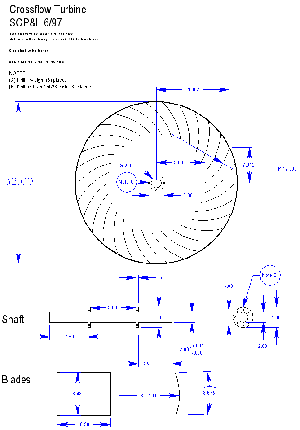
A crossflow looks like a squirrel cage blower with water coming in the outlet port, hitting the blades, flowing across the middle of the wheel, hitting the blades again and dropping out the bottom. The crossflow turbine was developed in Germany in the early thirties by Donat Banki or someone else, depending upon who you listen to. Mockmore and Merryfield did some good early work with the turbine which was later extended by Akerkar, Aziz & Desai and others. Needless to say there's wealth of data available on these machines. The strange thing is that there seems to be some kind of academic flame war over who invented it, and how to make it run the most efficiently. Stepping around the controversy (for the first time ever), here's how to build one:
The end plates that hold the blades are cut from 1/4 inch mild steel, the blades are 1/8" thick. The curved blades are made by slicing a 24 inch diameter steel pipe into sections with a torch and then grinding to prettiness. The shaft could have been more easily fabricated by keying the two collars, but I wanted this piece exactly right and had access to a lathe and some spare time. Hence the gross overkill of a solid, turned shaft. The drawing shows the runner pieces and was done in Ashlar Vellum, in case you just had to know.
If you have a burning desire to understand the relative motion problem involved in designing a crossflow, read Mockmore & Merryfield. They did an excellent job explaining what Banki did. If you can find Banki's Neu Wasserturbine, it's fantastic source material too. You'll note from the title that a working knowledge of technical German is helpful. If you want to build one of these beasts, take a look at the drawing and spreadsheet below. The drawing notes all the curves and dimensions that we need to compute, and the spreadsheet computes them. It's probably a good idea to try and make things come out in commercially available sizes, which you can do by tweaking the values in the left hand column.
The spreadsheet is based on Aziz' research on high efficiency crossflow runners in the Clemson University hydraulics lab. The outer diameter prediction gives you an idea how close your design falls to Aziz' predictive data for the most efficient runners tested. Aziz and Desai found that a nozzle entry arc of 90 degrees with a 30 blade runner results in a very efficient turbine.
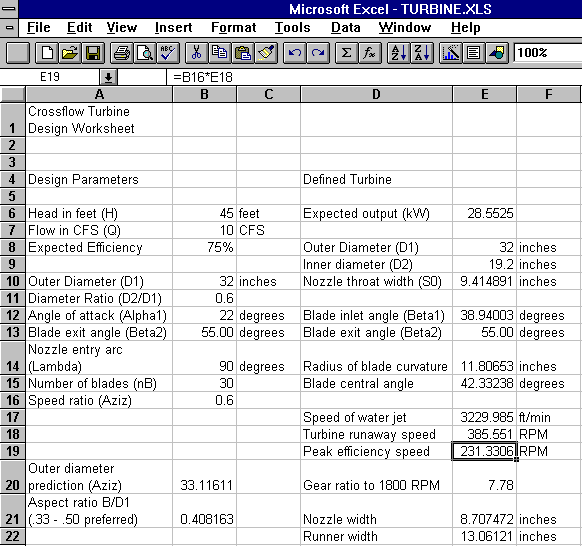
This spreadsheet in Excel format: turbine.xls.
SCP&L Unit #1 - Diesel Electric
A Trace 4024 inverter and a set of L16 batteries in the basement make our house operate like any other -- just plug something in and turn it on. We generate power to charge the battery set with a two cylinder Diesel engine turning a Newage alternator. We call the Diesel Stinky, because although she produces very little exhaust, the aroma of burning Greasel Fuel is unmistakable. Here's a picture of Stink doin' her 12 kW thing.
Living with a Diesel Generator
Stinky uses about one gallon of fuel every four (4) to six (6) hours with an oil change every five hundred hours or so. I prefer synthetic like Rotella (Shell), although Mobil One is much better stuff if you've got the bucks.
The system has worked almost flawlessly since the day we cranked her up. There was the time Stink instantly dumped six quarts of oil in my lap, but I knew I should have put the filter back on first ... Overall, no major problems. She starts every morning at 6 o'clock and runs until the batteries are topped off, unless we leave her running to power something big like the dryer or range. The house is all electric, except for the gas (and sometimes wood) heat, and no one seems to notice that there's anything different about the place until I show them the dungeon, er, battery room, that is.
Cost of Power
Here's a breakdown of what it really costs to generate your own power with a Diesel including an accrual for overhaul at 5000 hours:
Cost to Generate 1200 kWH
Fuel 25 gallons @ 0.65/gallon 16.25 Oil and filter (change + usage) 15.00 Spares, gaskets, Band-Aids 5.00 Repair accrual 8.50 Total cost $44.75 Cost per kWH: $0.0373 It costs a utility about $.045 to generate power, but their expenses are more labor than fuel. Which is to say they have efficient turbogenerators, but have to pay people to baby-sit them. The biggest cost for utilities isn't even in generating the power, it's in distributing it. All those poles and line crews run up the tab pretty fast. It's an interesting cocktail-party problem: which is the more efficent way of distributing energy? Pipelines full of hydrocarbon fuel turning local gensets, or long lines strung cross country from central generating plants? Given a set of assumptions and your best marginal analysis tools (or argumentation) you can see it's a close-run thing. Nearly a third of power generated by a big powerplant never reaches a paying customer. Hmm. It's like my other favorite three-Scotch analysis of which has higher bandwidth, a station wagon full of floppies driving 70 MPH or a T1 line. You've got to go a long way to beat a trunk-full of floppies hurtling down the interstate. I'm glad I went into engineering, but it does tend to limit one's party invites.
Generating your own power is cheaper, more reliable and better for the environment. Amazing that more people don't try it. It's kind of like baking bread at home: it's better stuff all the way around, but nowhere near as convenient as just buying some when you want it.
Tips for Buying and Storing Diesel Fuel
Diesel is a distillate fuel that can be made with a really primitive refinery and is closer to kerosene and heating oil than it is to gasoline in a petrochemical sense. Since it doesn't require high dollar hardware to make it's price rises and falls seasonally with delivered heating oil, not with what you pay for the MTBE-laden spooge you put in your car or chainsaw. So it follows that a load of Diesel is cheaper in the summer than it is in the winter. I paid 64 cents a gallon delivered in August of 1999. Things have gotten a little pricey since then -- I paid 92 cents a gallon for a load in Fall of 2002. I've got a thousand gallon tank from the junkyard and we buy fuel when it's cheap -- not when we need it. In North Carolina you can buy Farm Diesel for use in tractors, generators (and anything else that doesn't go over the road) tax free. I know we have to pay taxes to support our ever expanding population of people who just can't get it together, but I draw the line at paying road taxes for fuel that doesn't go over the road. It's just a bulk sample of a petrochemical, right?Diesel doesn't go bad like gasoline does as the butane and lighter fractions flash off, although Nasty Stuff does have a tendency to grow in it when it's warm. A good fuel filter with a replaceable element and drain is a must. Diesel also attracts water and draining the filter every now and again is a very Good Idea. With regard to Winterizing, according to Wendell who delivers my fuel, if you expect temperatures to drop into the teens (Fahrenheit) it's well worth shooting a little kerosene in the tank to keep your fuel from turning into Petro-Jello. Wendell dumped twenty gallons of kerosene in my 1000 gallon tank last winter and we had no jell problems down to near zero degrees F.
| Home | P l a n e | P r o j e c t s | S C P & L | A n i m al s | G a r d e n | O p i n i o n s | P h o t o s |
All rights reserved.
